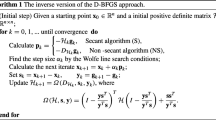Abstract
This paper focuses on entirety interpretation, representation and reconstruction of three-dimensional volume data sets based on the physical model of the data. The data model is represented by three-dimensional geometric model. The surfaces inside the datafield are extracted and matched to the model surfaces in order to reconstruct the new datafield based on the model. A conclusion is drawn that physical modeling provides a good basis and approach to interpret and represent the data sets. This paper also presents a subdivision algorithm to fast trace B-spline curve and the contrary algorithm is adopted to extract the geometry feature of the curve.
Similar content being viewed by others
References
Lorensen E. Marching cubes: A high resolution 3D surface construction algorithm.Computer Graphics, 1987, 21(4).
Cline E. Two algorithms for the three-dimensional reconstruction of tomograms.Med. Phys., 1988, 15(3).
Levoy M. Display of surface from volume data.IEEE CG&A, 1988.
Westover L. Footprint evaluation for volume rendering. InProc. SIGGRAPH'90.
Wilhelms J. A coherent projection for direct volume rendering. InProc. SIGGRAPH'90.
Upson C. V-buffer: Visible volume rendering. InProc SIGGRAPH'88.
Cai Wenli. Rendering of surface and volume details in volume data.Computer Graphics Forum, 1995, 14(3).
Bomans M. 3-D egmentation of MRI images of the head for 3-D display.IEEE Trans. on Medical Imaging, 1990, 9(2).
Cowe G. Fitting parameterized three-dimensional models to images.IEEE Trans. on PAMI, 1991, 13(5).
Solina F. Recovery of parametric models from range images: The case for superquadrics with global deformations.IEEE Trans. on PAMI, 1990, 12(2).
Kennedy N. Anatomic segmentation and volumetric calculations in nuclear magnetic resonance imaging.IEEE Trans. on Medical Imaging, 1989, 8(1).
Sander P. Inferring surface trace and differential structure from 3-D images.IEEE Trans. PAMI, 1990, 12(9).
Besl P. A method for registration of 3-D shapes.IEEE Trans. on PAMI, 1992, 14(2).
Besl P. The Free-Form Surface Matching Problem. InMachine Vision for Three Dimensional Scenes, Academic Press, 1990.
Brooks R. Model-based three-dimensional interpretations of two-dimensional images.IEEE Trans. on PAMI, 1983, 15(2).
Bolles R. 3DPO: A three-dimensional part orientation system.Int'l ournal of Robotics Research, 1986, 15(3).
Nevatia R. Description and recognition of complex-curved objects.AI, 1977, (8).
Author information
Authors and Affiliations
Additional information
This work was supported by the National Natural Science Foundation of China grant No.69303008.
Dong Feng received his M.S. degree in physics science from Zhejiang University in 1993. He is currently a Ph.D. candidate at State Key Lab. of CAD & CG, Zhejiang University. His research interests include physical modeling of visualization, three-dimensional medical image reconstruction, visualization of FEM datafield.
For the biography ofCai Wenli, Chen Tianzhou andShi Jiaoying, please refer to p.488, Vol.11, No.5 of this journal.
Rights and permissions
About this article
Cite this article
Dong, F., Cai, W., Chen, T. et al. Three-dimensional volume datafield reconstruction from physical model. J. of Comput. Sci. & Technol. 12, 217–230 (1997). https://doi.org/10.1007/BF02948972
Received:
Revised:
Issue Date:
DOI: https://doi.org/10.1007/BF02948972




